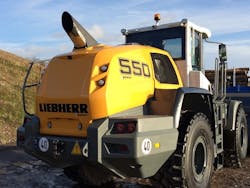How to Choose Vehicle Camera Technology
Vehicle Camera systems have become more common for trucks, construction vehicles, and other heavy equipment.
As well as aiding driver maneuverability, they support road and site safety by eliminating vehicle blind spots and helping to prevent incidents.
Deciding the type of vehicle camera to install can be confusing. Corey Heniser of Brigade Electronics provides some technical insight into which cameras are available, how they should be applied, and whether you should consider upgrading to high-definition format.
Front-view cameras
Front-view cameras are recommended for machinery, on-road haulage, and service and delivery vehicles. "Due to the size and elevated driver position of machinery and trucks, a blind spot often exists to the front,” Heniser says. “A front-view camera will eliminate this blind spot and help to prevent front vehicle damage.”
Side-view cameras
These are recommended for on-road vehicles, including trucks, buses, construction, and waste and refuse vehicles.
“The nearside blind spot is accountable for many collisions,” according to Heniser. “Most cyclists’ fatalities happen at low speeds, typically at intersections and when pulling away from a stationary position.”
Rear-view cameras
“Rear-view cameras are recommended for all vehicles,” Heniser says. “Regardless of the type of vehicle, the rear blind spot is a huge problem, with 90 percent of reversing incidents occurring off-road. And 25 percent of workplace deaths are caused by reversing vehicles.
“So reversing cameras are a crucial piece of technology to prevent costly collisions, reduce damage, and save lives,” Heniser says. “When choosing a camera, it’s worth bearing in mind health and safety directives in your area so that these are fully covered.”
360-degree cameras
“I think 360-degree cameras are a plus for all vehicles,” he says. “Intelligent camera monitor systems, like Brigade Backeye 360, are designed to assist low-speed maneuvering by providing the driver with a complete surround view of the vehicle in real time.”
Heniser says such ultra-wide angle cameras mounted to the front, sides, and rear of the vehicle capture the surrounding areas, including all blind spots. Simultaneous images from these cameras are then processed and “video stitched,” resulting in a 360-degree bird’s eye view in a single image.
Shutter cameras
Heniser recommends shutter cameras for construction, quarries, and waste and recycling.
“A shutter camera can improve the life and visibility of a reversing camera considerably,” he says. “Where vehicles operate in harsh environments, reversing cameras usually attract dirt and dust on the lens, blocking the driver’s view and rendering the camera useless. The shutter protects the camera by only revealing the lens when it is in use, reducing exposure time significantly.”
Some shutter cameras have operating temperatures as low as -40 F, Heniser says, and built-in heaters to melt ice, so they are designed to function in extreme temperatures.
Vehicle CCTV cameras
Incidents involving vehicles are time-consuming issues to resolve.
“Having recorded footage when there are conflicting reports of actual events, or being able to prove a staged accident, means companies can make major cost savings in the long-term,” Heniser says. “More importantly, they can also support their drivers, who are often the subject of increased scrutiny after an incident. Vehicle CCTV cameras provide an accurate witness and irrefutable evidence in the case of an incident.”
Are high-def cameras necessary?
One of the most recent additions to the vehicle camera system portfolio is high-definition (HD) cameras. “These do exactly what you would expect,” Heniser says. “They provide images in high-definition format, which are clearer and more defined. This makes HD ideal for industries such as construction and quarrying where safety is a huge concern.”
But Heniser points out there are a number of factors to consider before making the jump to HD.
“For example, if you already have a vehicle CCTV system installed, it’s most likely not compatible with the HD camera. Likewise, recording in HD format will require more data and therefore use up a lot more space on a hard drive, or it will tear through your data allowance for cloud-based storage far more quickly,” he says.
“In the event of a security incident, HD cameras are ideal for recording footage, supplying clearer images, and making it easier to identify individuals, number plates, and other important information that may be required for gathering evidence,” Heniser says.
Source: Brigade Electronics
